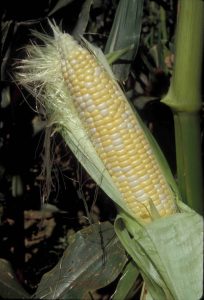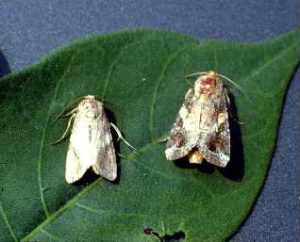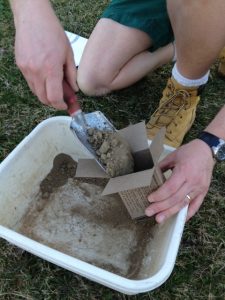Sweet Corn IPM Newsletter No. 10- September 4, 2020
 Sweet Corn IPM Newsletter No. 10 – September 4, 2020
Sweet Corn IPM Newsletter No. 10 – September 4, 2020
PEST NUMBERS MODERATE AS SEASON WINDS DOWN
Fall Armyworm Still Threatens Late Maturing Corn in Many Fields
SITUATION
Much needed showers offered some relief to dry fields this week. Many fields that planted for the Labor Day harvest matured earlier than expected, so supply for the coming weekend has been tight. Pest pressure has remained moderate, in spite of some warmer night temperatures. Some fields did not require protection this week, while others can extend intervals between sprays to protect any fresh silking corn remaining.

European corn borer:
Larval feeding injury was not over the 15% control threshold for pre-silking corn, and moth counts were not over the weekly threshold of five for silking corn at any location this week.

Corn earworm:
Moth captures were variable from site to site this week, but mostly lower. A four-day interval for silking corn was only recommended at one Cape Elizabeth site. A five-day spray interval was recommended in New Gloucester, and Poland Spring. A six-day spray interval was recommended in Biddeford, Dayton, and Levant.

Fall armyworm (FAW):
Moth captures declined at most sites this week, but were high enough in some fields to recommend protection for silking corn not presently under a spray interval for corn earworm. Counts exceeded the three-per-week threshold for silking corn in: Biddeford, Bowdoinham, Cape Elizabeth, Dayton, New Gloucester, Oxford, Wayne and Wells. Only the Biddeford site was also under a spray interval for corn earworm, so sprays were recommended for silking corn at all other sites.
When Should You Stop Spraying?
When a silking corn field is under a recommended spray interval for corn earworm, we usually recommend that spraying be stopped once the silks have become thoroughly dried and brown. At this stage, corn earworm moths are unlikely to lay eggs on it. However, if earworm pressure is very high (e.g. 91+ moths per week) and/or fall armyworm moths are over threshold (3 or more moths per week), then spraying should continue until either the moth counts drop or you reach the required days before harvest (dh) for the product being used.

Fall is a Great Time for Soil Testing:
Late summer to early fall is a good time to seed cover crops, and it is also a great time to check on the health of your soil. Having your soil tests results before the ground freezes allows time to correct soil pH with additions of lime, and incorporate any needed supplements into the soil, such as phosphorus, potassium, magnesium or other nutrients that are not prone to leaching. Fall applications of manure, lime and some nutrients are often preferable, because the fields are drier than in the spring, and the nutrients will have time to be worked into the soil before the plants need them. You can pick up soil test boxes and forms at any county office of the University of Maine Cooperative Extension, or call us here at Highmoor Farm if you’d like us to send you some. For details on soil testing at the University of Maine Analytical Laboratory and Soil Testing Service, you can visit their website
Sincerely,
David T. Handley
Vegetable & Small Fruit Specialist
Highmoor Farm Pest Mgmt. Unit
P.O. Box 179 17 Godfrey Drive
52 U.S. Route 202 Orono, ME 04473
Monmouth, ME 04259 1.800.287.0279
207.933.2100
| Location | CEW
Moths |
ECB
Moths |
FAW
Moths |
Recommendations / Comments |
|---|---|---|---|---|
| Auburn | 1 | 2 | 1 | No spray recommended |
| Biddeford | 3 | 1 | 13 | 6-day spray interval for all silking corn |
| Bowdoinham | 0 | 0 | 4 | One spray on silking corn for FAW |
| Cape Elizabeth I | 10 | 0 | 22 | 4-day spray interval for all silking corn |
| Cape Elizabeth II | 1 | 0 | 4 | One spray on silking corn for FAW |
| Charleston | 0 | 0 | 0 | No spray recommended |
| Dayton I | 3 | 3 | 5 | 6-day spray interval for all silking corn |
| Dayton II | 2 | 2 | 2 | 6-day spray interval for all silking corn |
| Levant | 2 | 0 | 1 | 6-day spray interval for all silking corn |
| Monmouth | 0 | 1 | 0 | No spray recommended |
| New Gloucester | 6 | 0 | 8 | 5-day spray interval for all silking corn |
| Oxford | 0 | 0 | 6 | One spray on silking corn for FAW |
| Poland Spring | 5 | 0 | 1 | 5-day spray interval for all silking corn |
| Sabattus | 1 | 2 | 0 | No spray recommended |
| Wayne | 1 | 3 | 15 | One spray on silking corn for FAW |
| Wells I | 0 | 0 | 1 | No spray recommended |
| Wells II | 0 | 0 | 7 | One spray on silking corn for FAW |
CEW: Corn earworm (Only fresh silking corn should be sprayed for this insect.)
ECB: European corn borer
FAW: Fall armyworm
| Moths caught per week | Moths caught per night | Spray interval |
|---|---|---|
| 0.0 to 1.4 | 0.0 to 0.2 | No spray |
| 1.5 to 3.5 | 0.3 to 0.5 | Spray every 6 days |
| 3.6 to 7.0 | 0.6 to 1.0 | Spray every 5 days |
| 7.1 to 91 | 1.1 to 13.0 | Spray every 4 days |
| More than 91 | More than 13 | Spray every 3 days |
Thresholds apply only to corn with exposed fresh silk. Lengthen spray intervals by one day if the maximum daily temperature is less than 80°F.
European Corn Borer Thresholds
Whorl stage: 30% or more of plants scouted show injury.
Pre-tassel-silk: 15% or more of plants scouted show injury.
Silk: 5 or more moths caught in pheromone traps in one week.
IPM Web Pages :
Where brand names or company names are used, it is for the reader’s information. No endorsement is implied nor is any discrimination intended against other products with similar ingredients. Always consult product labels for rates, application instructions and safety precautions. Users of these products assume all associated risks.
The University of Maine is an equal opportunity/affirmative action institution.
